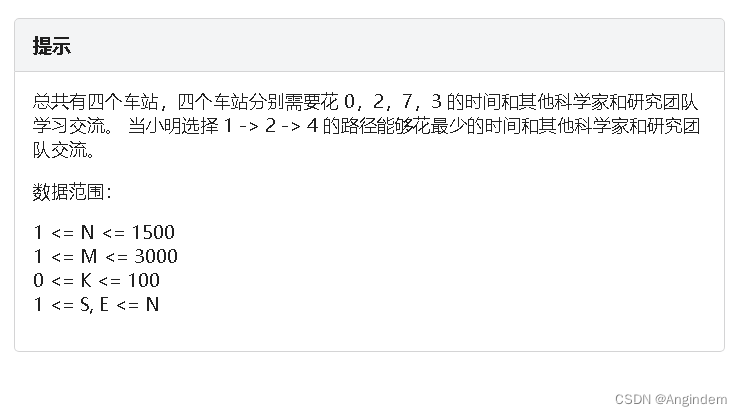题目:

样例:
|
| 5 |

思路:
由题意,很明显这是一道最短路径问题,但是不同的是,这里没有给出边的长度,而是以结点权值的形式,变相的作为边长,这一我们应该注意的是,这里的意思为
从 a 点到 b点所花时间为 b 即 g[a][b] = b ,从 b 点到 a 点所花时间为 a 即 g[b][a] = a
所以我们根据题意,更改一下Dijkstra模板函数即可。
代码详解如下:
#include <iostream>
#include <cstring>
#include <algorithm>
#include <queue>
#include <unordered_map>
#define endl '\n'
#define int long long
#define YES puts("YES")
#define NO puts("NO")
#define umap unordered_map
#define INF 0x3f3f3f3f
#define All(x) (x).begin(),(x).end()
#pragma GCC optimize(3,"Ofast","inline")
#define ___G std::ios::sync_with_stdio(false),cin.tie(0), cout.tie(0)
using namespace std;
const int N = 1500 + 10;
int n,m;
int g[N][N]; // 所到结点所花的时间,即路径长度
umap<int,int>dist; // 记录最短路径
umap<int,int>d; // 记录结点权值,即所花时间
umap<int,bool>st;
inline int Dijkstra()
{
// 初始化起点最短距离
dist[1] = d[1];
// 初始化 dist ,走一遍起点到每一个点的最短距离
for(int i = 2;i <= n;++i)
{
dist[i] = g[1][i];
}
// 从起点走完一遍后,标记起点我们检查过了
st[1] = true;
// 这里 i = 2 是因为我们刚开始已经走过一遍起点了
for(int i = 2;i < n;++i)
{
// t 探头探索哪一个点所花时间最少,即最短距离
int t = -1;
for(int j = 1;j <= n;++j)
{
if(!st[j] && (t == -1 || dist[j] < dist[t])) t = j;
}
// 标记并走向该结点
st[t] = true;
// 更新所有结点最短距离
for(int j = 1;j <= n;++j)
{
dist[j] = min(dist[j],dist[t] + g[t][j]);
}
}
// 这里返回结果最后加上 d[1] 是因为可能起点也有需要花费的时间
return dist[n] + d[1];
}
inline void solve()
{
memset(g,INF,sizeof g);
cin >> n >> m;
// 输入结点权值
for(int i = 1;i <= n;++i)
{
cin >> d[i];
}
while(m--)
{
int a,b;
cin >> a >> b;
// 记录 a 点 到 b 点 的距离
g[a][b] = d[b];
// 记录 b 点 到 a 点 的距离
g[b][a] = d[a];
}
int ans = Dijkstra();
cout << ans << endl;
}
signed main()
{
// freopen("a.txt", "r", stdin);
___G;
int _t = 1;
// cin >> _t;
while (_t--)
{
solve();
}
return 0;
}